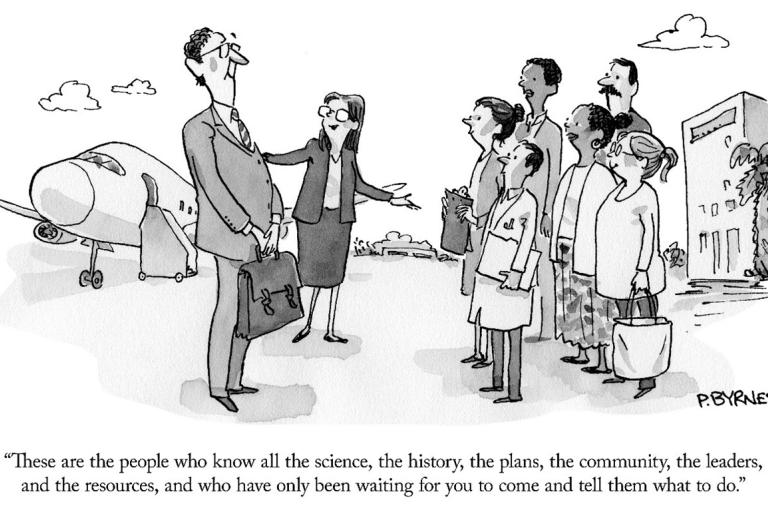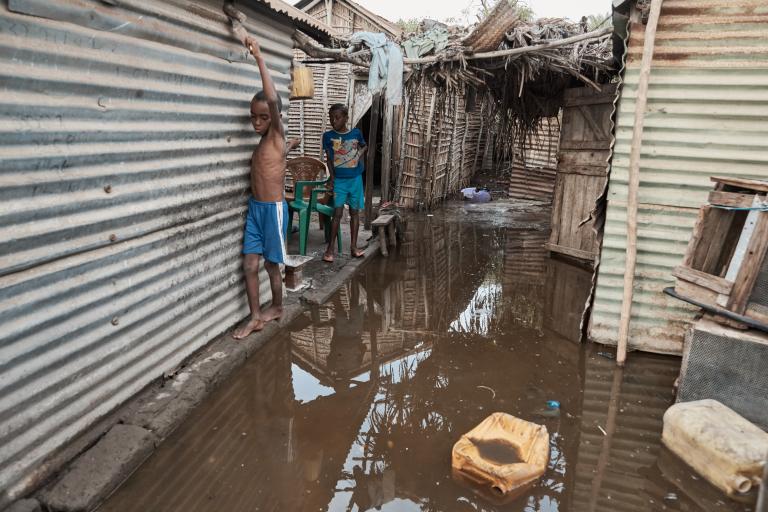A Financing Perspective on Tailoring WMO Technical Assistance to Members’ Needs
- Author(s):
- John Harding, CREWS Secretariat and Lina Sjaavik and Jean-Baptiste Migraine, WMO Secretariat

The WMO Strategic Plan 2024–2027 envisions “a world where all nations, especially the most vulnerable, are more resilient to the socioeconomic consequences of extreme weather, climate, water and other environmental events”. It outlines the role of the WMO Secretariat in supporting Members to achieve this vision by closing the growing capacity gap in weather, climate, hydrological and related environmental services and by realigning WMO structure and programmes for more effective policy- and decision-making and implementation. This requires financing and robust programming frameworks that allow Members to define their priorities and needs and that ensure that development aid addresses those needs.
Drawing on practical examples from the Climate Risk and Early Warning System (CREWS), the primary provider of extra-budgetary funds to WMO, this article will look at how WMO currently works with Members to define their funding priorities, the principles that drive this process and the tools being used to see what is working well and where challenges remain. It further proposes steps to make the system more robust.
WMO financing principle
All development financing is driven by principles of aid effectiveness. The first principle identified in the Paris Declaration on Aid Effectiveness of 2005 is country ownership – the need for developing countries to set their own development strategies and priorities. Whereas the context for development cooperation has changed since then, not least with global challenges such as climate change becoming more prevalent, the principle of country-driven development continues to provide the momentum for most global financing mechanisms and institutions, including WMO.
While arguably the most obvious of principles, several reports by the Organisation for Economic Co-operation and Development (OECD) demonstrate that this principle is one of the most challenging for development partners to apply. This is primarily due to the multitude of development priorities and actors, competition, inclusive global agendas, conditions for financing and limited resources.
To better align its services with needs and priorities identified by its Members, WMO encourages NMHSs to adopt strategic plans in line with the Strategic Planning Handbook. It applies an Earth system approach that requires cross-cutting collaboration, combining different disciplines, including meteorology, climatology, hydrology, environmental and social sciences. It also requires better alignment between disciplines to provide enhanced products and services, including weather forecasting, climate projections, flood and drought warnings, and air quality and health services. Members are encouraged to define their priorities and needs to function as authoritative voices on science-based information that helps societies build resilience and adapt to a changing climate.
WMO has long coordinated technical assistance and capacity building most effectively through peer-to-peer support between Members with the required expertise, knowledge of the country context and resources. The Organization has various mechanisms, such as the Voluntary Cooperation Programme (VCP), CREWS and the Systematic Observation Financing Facility (SOFF) and bilateral donors, that promote this peer-to-peer technical assistance through their funding and operational modalities.
WMO also applies a principle of mutualization of its Members’ capacities: certain Members provide services for groups of countries, through the designation of global and regional centres for observations, data processing, weather forecasting, climate predictions and capacity building. This requires a combination of regional and national interventions to identify and address national needs and can result in economies of scale for monitoring and forecasting large-scale events such as tropical cyclones, droughts, sand and dust storms and flooding over large watersheds. It is in recognition of this that CREWS allows financing for institutional development and capacity building at both the national and regional levels. An understanding of the economies of scale is a basis for effective financing decisions.

Identification of needs
For years, WMO Members reported on the status of their national systems through surveys. The updated practice, with the WMO Core Dataset of the WMO Community Platform, is to facilitate the compilation of information with a tool that contains Members’ existing data and prompts them to update it.
Needs and gaps have also been collected by WMO from its Members related to specific programmes or agendas. For example, the Global Framework for Climate Services (GFCS) invites WMO Members to provide information through a Checklist on Climate Services, which has been the basis for the State of Climate Services reports published since 2019. Member self-evaluations are quality-controlled by peers in the Climate Services Dashboard.
The Alliance for Hydromet Development developed the Country Hydromet Diagnostics to standardize approaches to assess maturity of country-level meteorological and hydrological services. It incorporates the Climate Services Checklist and aims to guide development partners' investments, considering the full NMHS value chain. SOFF applies the Diagnostic tool, which was tested in nine countries in 2021, through a peer-to-peer assessment process. As of May 2024, 18 countries have produced reports based on the Diagnostic tool.
The Multi-Hazard Early Warning Systems Checklist (WMO, 2016), which has been used as a blueprint for the development of the Early Warnings for All Checklist for Gap Analysis, provides a useful framework for assessing national capacities. The Early Warnings for All dashboard includes global, implementation and country capacity indicators for monitoring progress towards the 2027 deadline for delivering on the initiatives promise (see MeteoWorld No 1/2024). The identification of gaps in hazard monitoring and forecasting capacities in the 30 countries prioritized for Early Warning for All implementation is the first target of the Checklist, which will then expand to cover the entire value chain for effective Multi-Hazard Early Warning Systems. The approach is expected to inform the development of an early warning maturity index.
Most needs assessments by NMHSs, however, are carried out in the context of projects linked to specific financing opportunities. These relate to multiple and diverse sources of financing such as development banks, either as grants or concessional loans. The World Bank has the largest portfolio of hydrometeorological modernization projects amounting to US$ 1.5 billion. Climate funds, such as the Green Climate Fund (GCF) and the Adaptation Fund also have growing portfolios financing NMHSs. Funding is also provided by bilateral development partners, either directly or through their respective meteorological agencies' development assistance mechanisms. The Met Office’s (United Kingdom) Weather and Climate Information Services for Africa (WISER) is an example of such assistance.
How CREWS aligns its financing with country priorities
To avoid over-burdening Members and duplicating work, whenever possible, CREWS uses existing country assessments and reports. When national partners request assessments, CREWS assures that these align with established standards and tools such as the Country Hydromet Diagnostics and the Early Warning for All’s Checklist for Gap Analysis. However, CREWS advocates for such assessment tools to be further enriched by analysis to demonstrate the wider socioeconomic benefits of weather, climate and water-related services and of institutional capacity development of meteorological and hydrological services.
There are several examples of targeted and highly specialized assessments, as well as needs and gap analyses, financed by CREWS at the request of national and regional institutions. In the Comoros, CREWS funding permitted the NMHS to carry out a detailed diagnostic of the national early warning system capacities with support from WMO and other partners. In turn, that assessment permitted the World Bank, as part of the CREWS South-West Indian Ocean project, to help the Government to develop an investment plan for early warning systems. The plan informed discussions regarding Early Warnings for All national priorities in the Comoros and promoted alignment with several other development partners in the country such as United States Agency for International Development (USAID), SOFF and GCF. CREWS facilitated similar diagnostics for many of the other countries involved in the CREWS South-West Indian Ocean project.
The CREWS Pacific Small-Island Developing States (SIDSs) and upcoming CREWS Pacific Drought projects are being implemented and developed in support of and in alignment with the Weather Ready Pacific programme. This ensures that CREWS financing is supporting nationally identified needs and priorities in the region.
Looking ahead – challenges and opportunities
The Early Warning for All initiative provides an opportunity to build a better collective understanding of how WMO and development partners can assist Members with the analysis of their integrated, multi-hazard early warning system status and needs. Country ownership is the primary principle for financing that addresses capacity needs.
Methodologies to guide assessments should be comprehensive, however, existing national assessments should be used whenever possible to avoid duplicating work. The methodologies of SOFF’s Country Hydromet Diagnostics and the Early Warning for All’s Checklist for Gap Analysis, offer good practice in this regard but there is a need for such assessments to demonstrate the wider socioeconomic benefits.
WMO, the United Nations agencies and development partners are responsible for ensuring that assessments also account for the needs and perspectives of marginalized groups and communities. These include minorities, internally displaced and refugee populations who would require targeted early warning and climate services. In fragile and conflict affected countries, humanitarian actors, such as National Red Cross and Red Crescent Societies, would be key partners with their own assessments.
Strong national legislative and institutional frameworks remain a cornerstone of nationally led and owned need assessments. WMO has supported the development, and in several cases the adoption by parliaments, of 58 hydrometeorological national strategies and plans with CREWS financing. These provide the frameworks and basis for consolidated nationally owned definitions of needs and priorities.
The efforts of WMO to assist its NMHSs in defining their gaps, needs and priorities in an integrated manner is being greatly enhanced by better standards for self-assessments. However, procedures for collecting and compiling Members’ information need to be further streamlined. Assessment should be across sectors, including, for example National Disaster Management Offices, and across hazards. The development of national hydrometeorological strategies and plans should also become more systematic. Global and regional capacity and services should also be accessible at the national levels to ensure that the early warnings address the needs of the most exposed and vulnerable populations.


